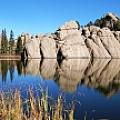
Blazing Black Hills Sunset

by Greni Graph
Title
Blazing Black Hills Sunset
Artist
Greni Graph
Medium
Photograph - Photography
Description
Sunset or sundown is the daily disappearance of the Sun below the western half of the horizon, i.e. at an azimuth greater than 180 degrees, as a result of Earth's rotation. The time of sunset is defined in astronomy as the moment when the trailing edge of the Sun's disk disappears below the horizon. The ray path of light from the setting Sun is highly distorted near the horizon because of atmospheric refraction, making the sunset appear to occur when the Sun�s disk is already about one diameter below the horizon. Sunset is distinct from dusk, which is the time at which the sky becomes completely dark, which occurs when the Sun is approximately eighteen degrees below the horizon. The period between sunset and dusk is called twilight. Locations north of the Arctic Circle and south of the Antarctic Circle experience no sunset or sunrise at least one day of the year, when the polar day or the polar night persist continuously for 24 hours. Sunset creates unique atmospheric conditions such as the often intense orange and red colors of the Sun and the surrounding sky. As a ray of white sunlight travels through the atmosphere to an observer, some of the colors are scattered out of the beam by air molecules and airborne particles, changing the final color of the beam the viewer sees. Because the shorter wavelength components, such as blue and green, scatter more strongly, these colors are preferentially removed from the beam. At sunrise and sunset, when the path through the atmosphere is longer, the blue and green components are removed almost completely leaving the longer wavelength orange and red hues we see at those times. The remaining reddened sunlight can then be scattered by cloud droplets and other relatively large particles to light up the horizon red and orange. The removal of the shorter wavelengths of light is due to Rayleigh scattering by air molecules and particles much smaller than the wavelength of visible light (less than 50 nm in diameter). The scattering by cloud droplets and other particles with diameters comparable to or larger than the sunlight's wavelengths (> 600 nm) is due to Mie scattering and is not strongly wavelength-dependent. Mie scattering is responsible for the light scattered by clouds, and also for the daytime halo of white light around the sun (forward scattering of white light). Without Mie scattering at sunset and sunrise, the sky along the horizon has only a dull-reddish appearance, while the rest of the sky remains mostly blue and sometimes green. Sunset colors are typically more brilliant than sunrise colors, because the evening air contains more particles than morning air. Ash from volcanic eruptions, trapped within the troposphere, tends to mute sunset and sunrise colors, while volcanic ejecta that is instead lofted into the stratosphere (as thin clouds of tiny sulfuric acid droplets), can yield beautiful post-sunset colors called afterglows and pre-sunrise glows. A number of eruptions, including those of Mount Pinatubo in 1991 and Krakatoa in 1883, have produced sufficiently high stratospheric sulfuric acid clouds to yield remarkable sunset afterglows (and pre-sunrise glows) around the world. The high altitude clouds serve to reflect strongly-reddened sunlight still striking the stratosphere after sunset, down to the surface. Sometimes just before sunrise or after sunset a green flash can be seen. dakota, light, photography, sunset, sunrise, tree, mountain, purple, lavender, orange, yellow, pine, black hills, south dakota #201208293045
Uploaded
August 31st, 2012
Statistics
Viewed 157 Times - Last Visitor from Fairfield, CT on 04/06/2024 at 3:53 AM
Embed
Share
Sales Sheet
Comments
There are no comments for Blazing Black Hills Sunset. Click here to post the first comment.






















































